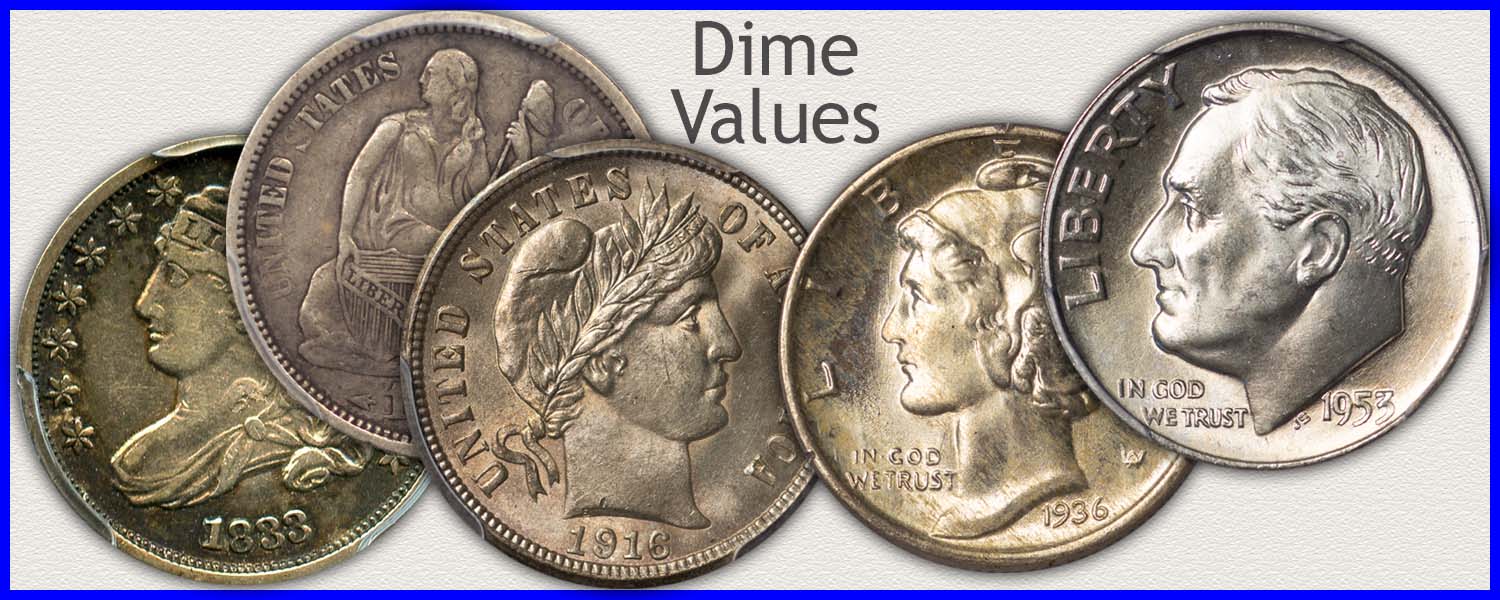Coin Values Moving with Precious Metals: Up-Dated 4/7/2025: Gold $3035 | Silver $30.08
Silver Roosevelt Dime Values
Silver Roosevelt dime values are tied directly to the current price of silver. With silver at $30.08 per ounce. Each circulated dime dated 1946 to 1964 is worth $2.01 .
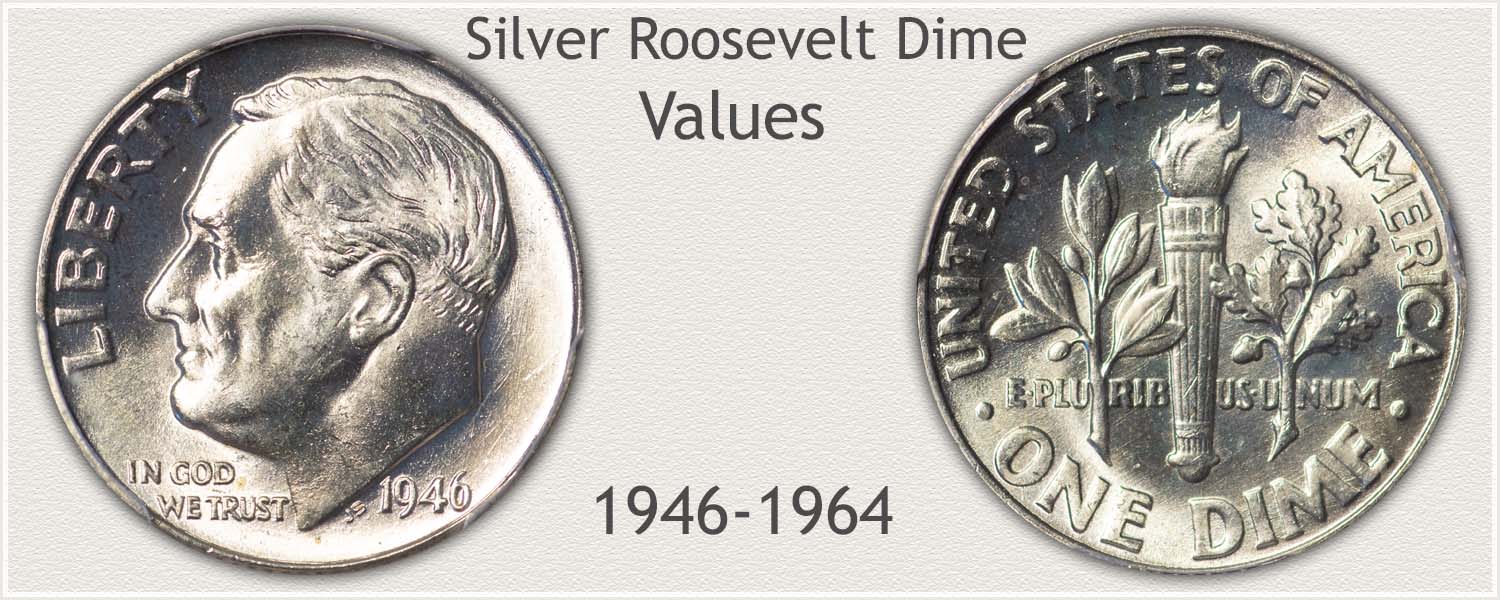
Steps Leading to Value:
- Step 1: Date and Mintmark Variety - Identify the dates and mintmarks with above average value.
- Step 2: Grading Condition - Judge how well you coin is preserved and potential higher collector demand.
- Step 3: Special Qualities - Recognize the clear separation in the Roosevelt dime market; bullion examples and those sought by collectors.
Minted and saved in the millions, today Mint State coins are sought for high end collections. These coins are bright, like new, no wear, and virtually mark free. Beginning to find a following are the affordable, nice circulated coins as an entry to new and young collectors.
| Roosevelt Dime Values 1946 to 1964 | ||||
|---|---|---|---|---|
| Condition of Coin | ||||
| Date | Good | Fine | Extremely Fine | Mint State |
| Roosevelt Dime Values Updated | 4/7/2025 | |||
| 1946 | $2.01 | $2.01 | $2.01 | $3.32 |
| 1946 D | $2.01 | $2.01 | $2.01 | $3.32 |
| 1946 S | $2.01 | $2.01 | $2.01 | $3.32 |
| 1947 | $2.01 | $2.01 | $2.01 | $6.31 |
| 1947 D | $2.01 | $2.01 | $2.01 | $6.31 |
| 1947 S | $2.01 | $2.01 | $2.01 | $6.31 |
| 1948 | $2.01 | $2.01 | $2.01 | $4.16 |
| 1948 D | $2.01 | $2.01 | $2.01 | $6.31 |
| 1948 S | $2.01 | $2.01 | $2.01 | $4.16 |
| 1949 | $2.01 | $2.01 | $4.54 | $20 |
| 1949 D | $2.01 | $2.01 | $2.39 | $6.31 |
| 1949 S | $2.01 | $2.01 | $5.86 | $35 |
| 1950 | $2.01 | $2.01 | $2.39 | $6.31 |
| 1950 D | $2.01 | $2.01 | $2.01 | $6.31 |
| 1950 S | $2.01 | $2.01 | $5.86 | $28 |
| 1951 | $2.01 | $2.01 | $2.01 | $3.32 |
| 1951 D | $2.01 | $2.01 | $2.01 | $3.32 |
| 1951 S | $2.01 | $2.01 | $3.40 | $15 |
| 1952 | $2.01 | $2.01 | $2.01 | $3.32 |
| 1952 D | $2.01 | $2.01 | $2.01 | $3.32 |
| 1952 S | $2.01 | $2.01 | $2.01 | $6.31 |
| 1953 | $2.01 | $2.01 | $2.01 | $2.78 |
| 1953 D | $2.01 | $2.01 | $2.01 | $2.61 |
| 1953 S | $2.01 | $2.01 | $2.01 | $2.61 |
| 1954 | $2.01 | $2.01 | $2.01 | $2.61 |
| 1954 D | $2.01 | $2.01 | $2.01 | $2.61 |
| 1954 S | $2.01 | $2.01 | $2.01 | $2.48 |
| 1955 | $2.01 | $2.01 | $2.01 | $2.48 |
| 1955 D | $2.01 | $2.01 | $2.01 | $2.48 |
| 1955 S | $2.01 | $2.01 | $2.01 | $2.48 |
| 1956 | $2.01 | $2.01 | $2.01 | $2.61 |
| 1956 D | $2.01 | $2.01 | $2.01 | $2.48 |
| 1957 | $2.01 | $2.01 | $2.01 | $2.48 |
| 1957 D | $2.01 | $2.01 | $2.01 | $2.78 |
| 1958 | $2.01 | $2.01 | $2.01 | $2.48 |
| 1958 D | $2.01 | $2.01 | $2.01 | $2.78 |
| 1959 | $2.01 | $2.01 | $2.01 | $2.48 |
| 1959 D | $2.01 | $2.01 | $2.01 | $2.48 |
| 1960 | $2.01 | $2.01 | $2.01 | $2.48 |
| 1960 D | $2.01 | $2.01 | $2.01 | $2.48 |
| 1961 | $2.01 | $2.01 | $2.01 | $2.48 |
| 1961 D | $2.01 | $2.01 | $2.01 | $2.48 |
| 1962 | $2.01 | $2.01 | $2.01 | $2.48 |
| 1962 D | $2.01 | $2.01 | $2.01 | $2.48 |
| 1963 | $2.01 | $2.01 | $2.01 | $2.48 |
| 1963 D | $2.01 | $2.01 | $2.01 | $2.48 |
| 1964 | $2.01 | $2.01 | $2.01 | $2.48 |
| 1964 D | $2.01 | $2.01 | $2.01 | $2.48 |
The above are wholesale Roosevelt dime values. Computed from dealer's price lists with various mark-up factors figured in. They reflect closely the value you would expect to receive when selling.
Variations in value do occur subject to subtle grading points, collector demands and dealer needs. For more background information, see how value listings in the above Coin Value Guide are determined.
Step 1: | Date and Mintmark Confirmed
Roosevelt dimes replaced the Mercury dime in 1946. In the beginning of the series all dimes continued with an alloy of 90% silver to 10% copper. Because of silver content all dimes 1946 to 1964 are worth well above face value.
President Franklin Delano Roosevelt is portrayed on the obverse, first dimes released on January 30, 1946. Reverse is a "Liberty" torch. On the sides of the torch are an olive branch - peace and oak branch - strength and independence.
Silver Roosevelt dimes are beginning to gain popularity as an interesting set to collect because of silver content. A few dates and mintmark combination are considered premium coins. The following images identify the different mints and their mintmarks within the silver Roosevelt variety.
Mints and Mintmarks of Silver Roosevelt Dimes
San Francisco Mint Silver Roosevelt Dime
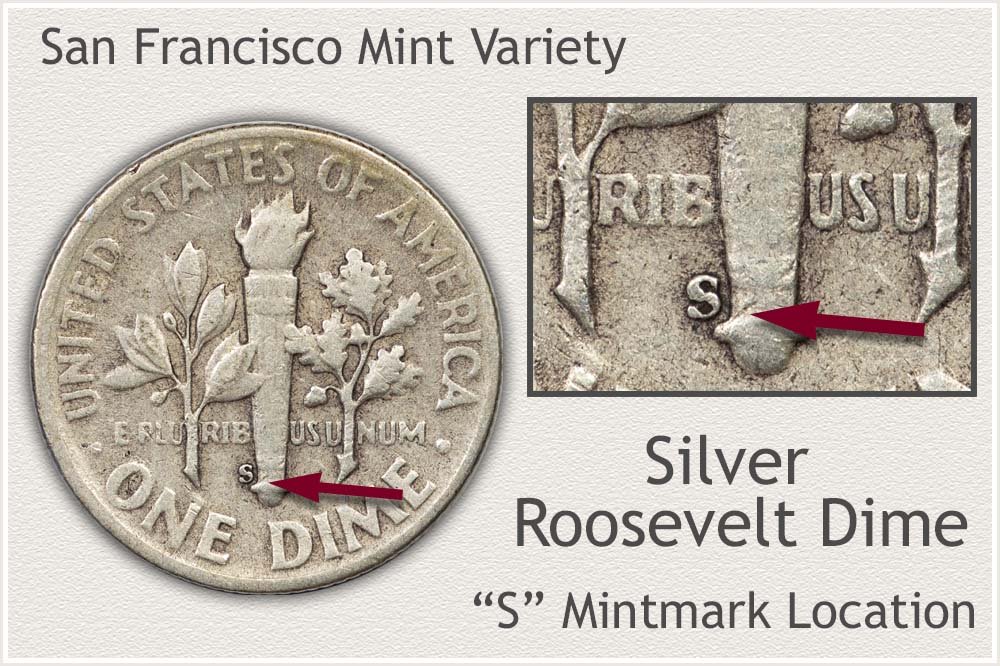
San Francisco mint struck Roosevelt dimes of the silver variety from 1946 to 1955 when the mint closed coinage operations. Over 288 million dimes, lowest total of the three mints striking dimes of the silver variety. A small "S mintmark is on the reverse at the base of the torch, to identify its production.
Denver Mint Silver Roosevelt Dime
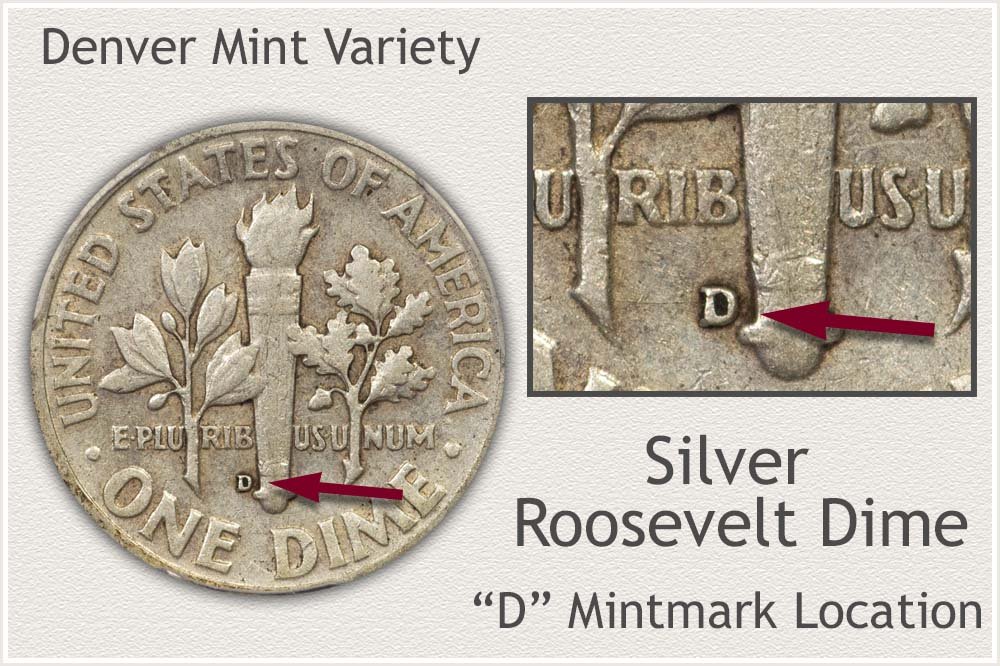
Denver leads in total number of silver Roosevelt dimes. 4.7 billion coins, far outnumbering both the main Philadelphia mint and San Francisco branch. These are available in quantities both in circulated and mint state condition. Denver's mintmark, a small "D" is on the reverse at the base of the torch.
Philadelphia Mint Silver Roosevelt Dime
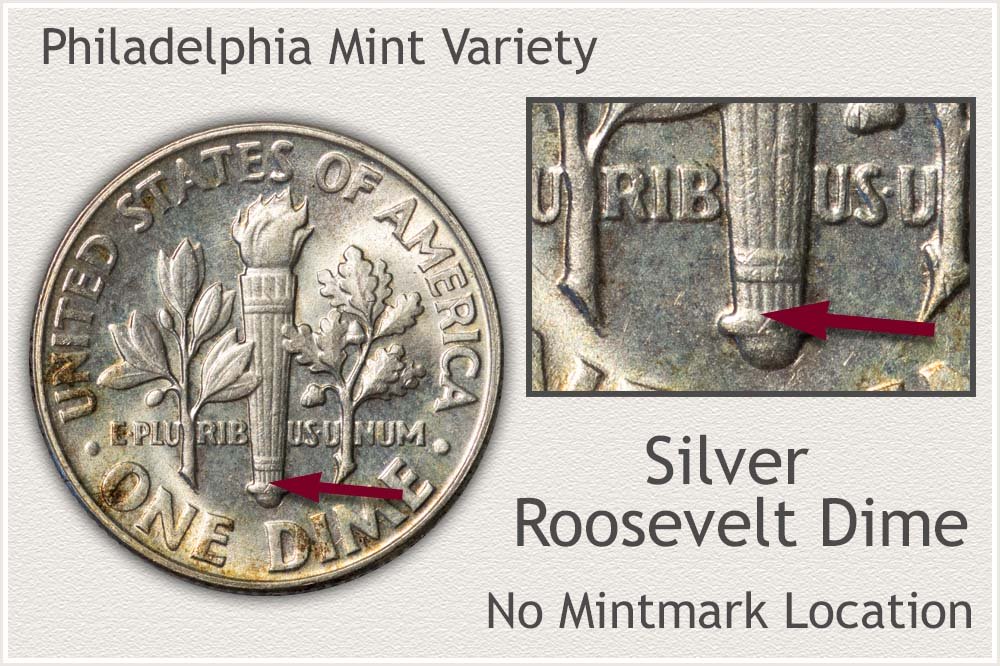
Philadelphia, the main mint, struck silver dimes in each year; 1946 to 1964 producing over 2.6 billion pieces. Philadelphia is also known for the lowest number minted for any single year and mint variety. A 12,828,381 mintage of 1955, lowest of the silver Roosevelt dime variety. No mintmark was use during the silver series by Philadelphia. At the base of the torch on the reverse, if no mintmark is present Philadelphia struck the coin.
Step 2: | Grading Condition | Determines Grade
Collectors and their preferences determine silver Roosevelt dime value. Today the silver issues dated 1946 to 1964 are primarily sought in Mint State - uncirculated condition. This top end grade is affordable throughout the series and leaves any coin with circulation wear as a secondary choice.
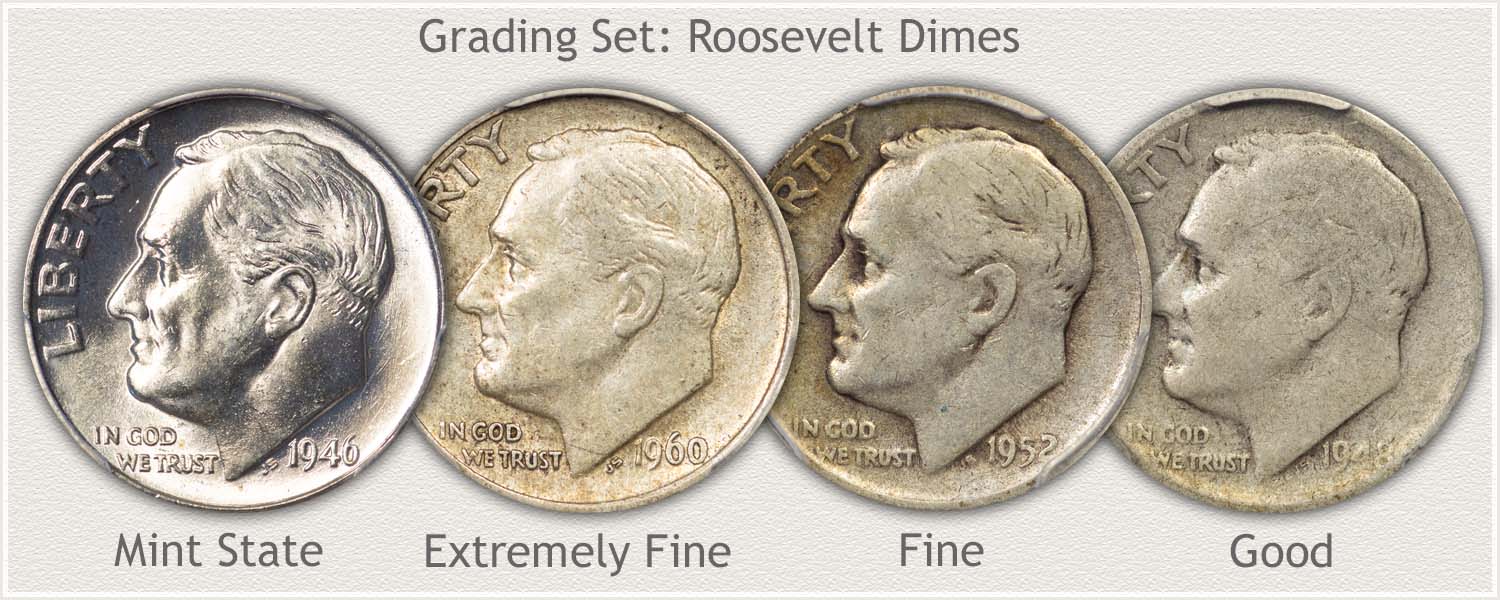
Mint State Roosevelt Dimes are Premium Value
Grading your Roosevelt dime separates the bullion value quality coins from the collectible examples worth more. Comparing to images identifies factors for each stage of condition and helps visualize how to grade these dimes.
Mint State Grade: Roosevelt Dime
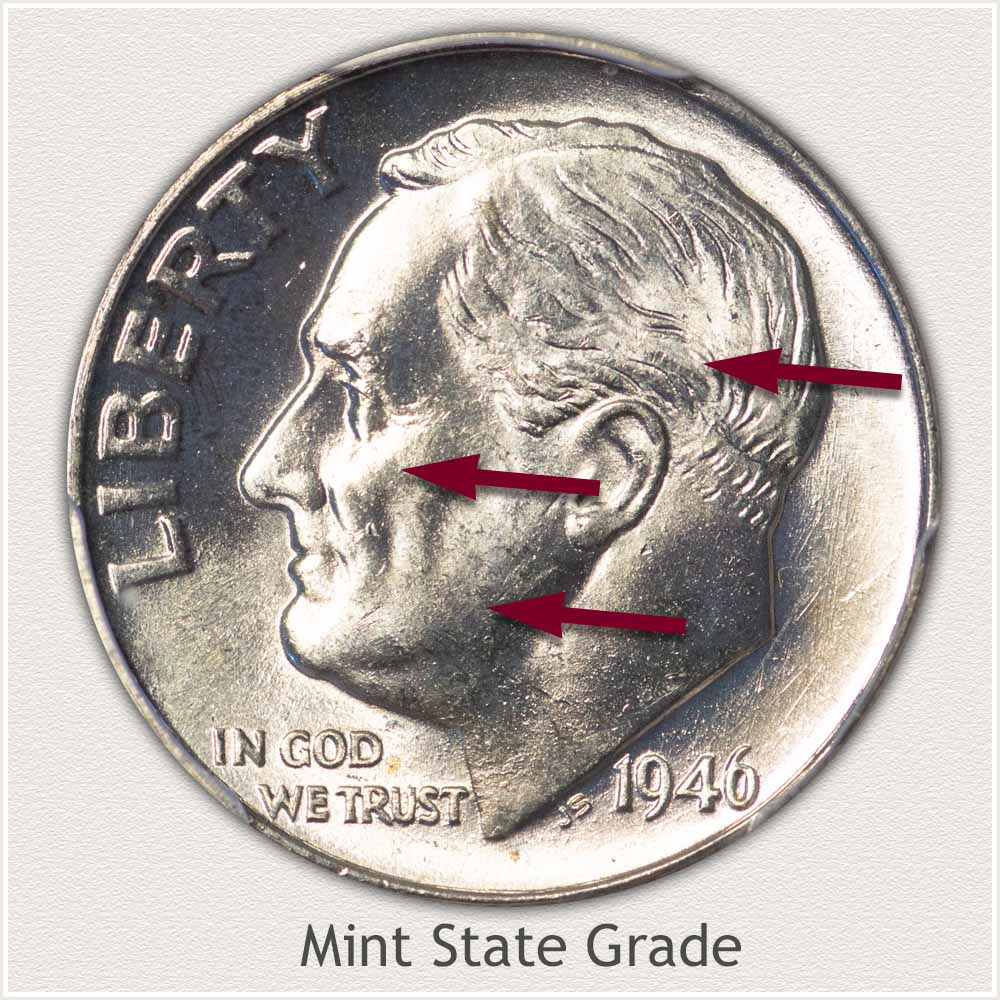
Obverse: Features Identifying Mint State Grade: Traces of wear to the surface decides if a coin is uncirculated or a lower grade. First signs of wear are visible by the removal of luster across high points of the coin. Luster, a delicate fine grain to the metal produces the shine and is the original surface of the coin when minted.
Centrally located and high in relief is the hair over Roosevelt's ear. Inspect closely to detect any smoothing to the metal.
Dulling of the cheek below the eye is a sign of wear. A fine-grained surface needs to remain on the upper contours of the cheek, jaw line, and Roosevelt's neck. Compare lower areas of contours of the face to match higher areas for matching qualities of luster and texture.
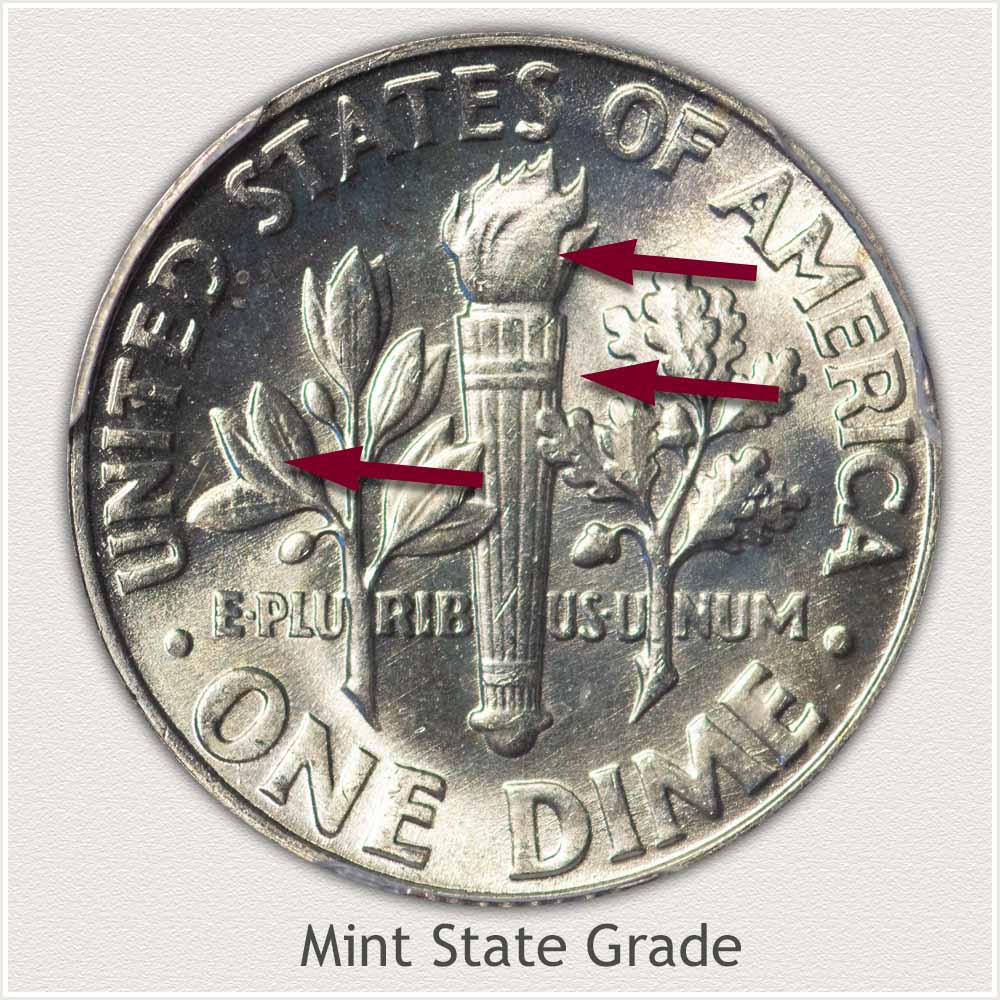
Reverse: Features Identifying Mint State Grade: A reverse free of wear requires absence of smoothing from high areas of the touch flame and leaves on both sides of the touch.
A broad surface at the base of the flame is high in relief with tips of flames prone to first wear. A consistent shine and luster is present to the surface on a Mint State grade dime.
Fine details are horizontal bands at both the top and bottom of the torch. Judge the surface of these bands is free of any smoothing to the metal and matches surrounding surfaces.
Leaf edges are next viewed for evidence of wear. No smoothing to the metal confirms the grade.
Extremely Fine Grade: Roosevelt Dime
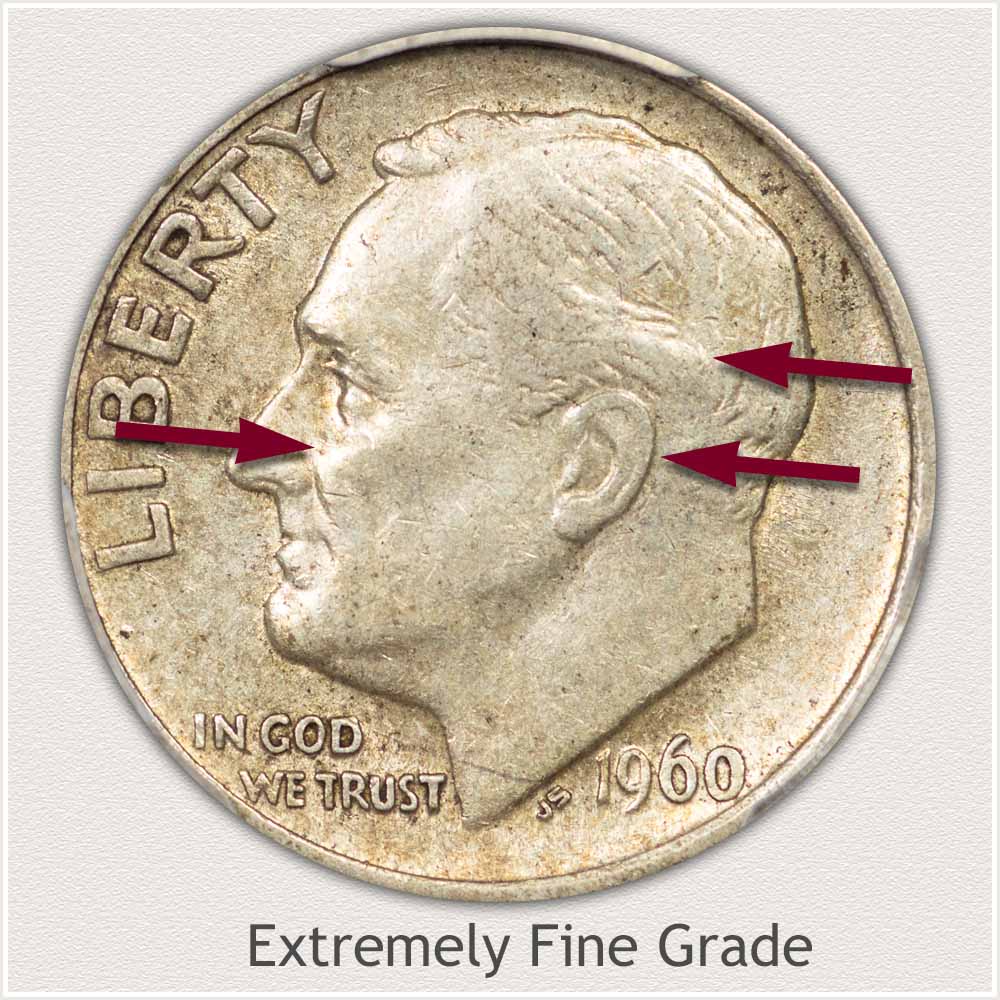
Obverse: Features Identifying Extremely Fine Grade: A slight amount of wear is visible on a coin in Extremely Fine condition. Wear is limited to only the high contour areas.
Inspect the hair just above Roosevelt's ear. A few of the fine lines have disappeared. A small flat area is now in place of these lines. Hair remains well detailed towards the top of his head and along the back.
Roosevelt's cheek just below the eye displays a smooth surface with just a small flat area.
Looking closely at the outer edge of Roosevelt's ear, the once rounded edge is flattened.
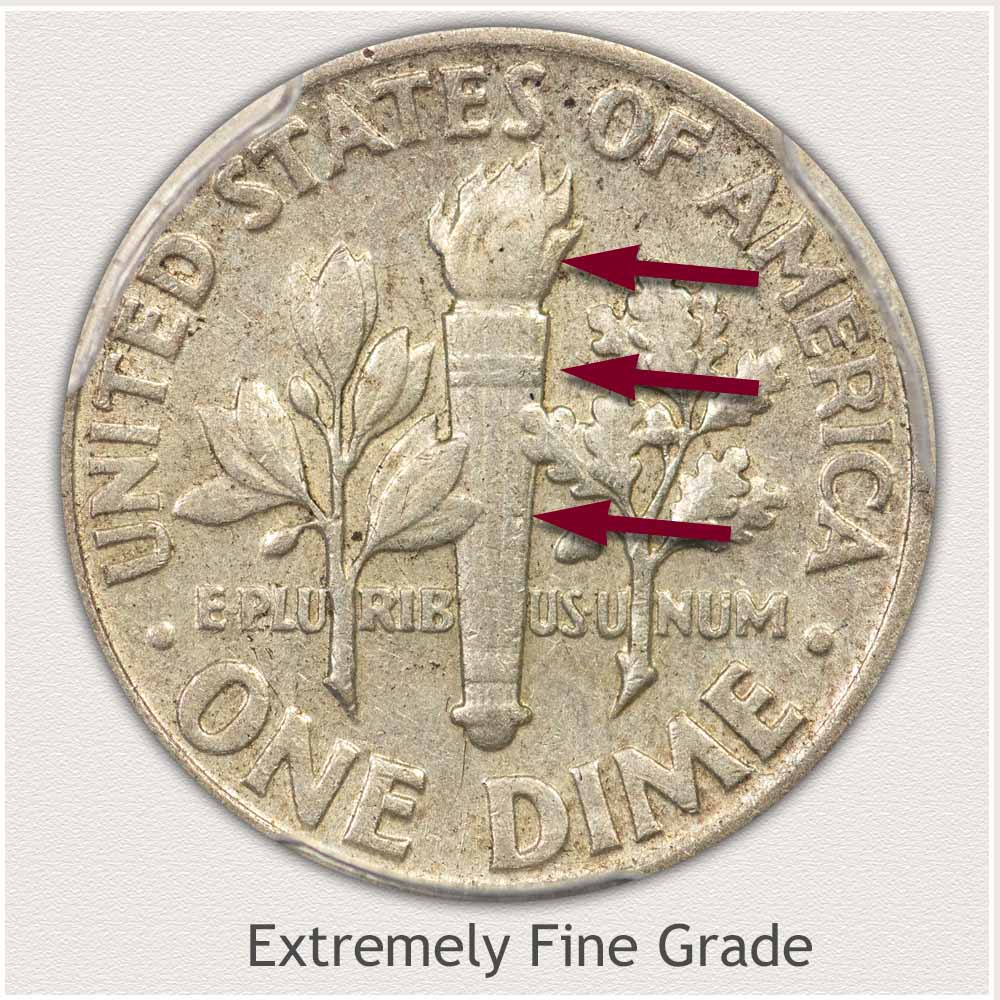
Reverse: Features Identifying Extremely Fine Grade: Light wear has replaced mint luster on high areas of the design and dulled the shine of most letters.
Wear is evident in the flame. A small flat area is in the center of the flame; however, detail remains separating the individual flames.
Two horizontal bands across the vertical lines of the handle to the torch are well defined and raised.
Vertical lines of the torch handle are visible. Weakness of these lines is often found with just a few lines merged. A sharp looking torch must remain.
Fine Grade: Roosevelt Dime
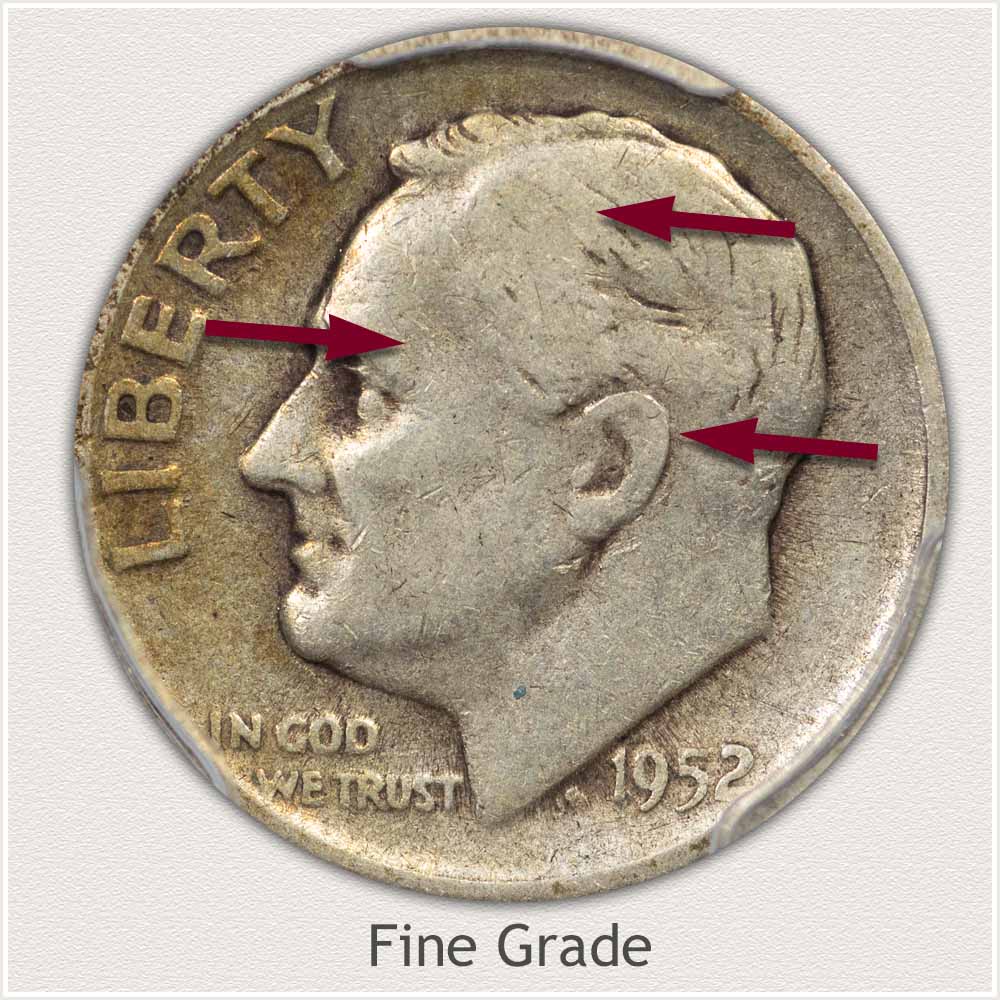
Obverse: Features Identifying the Fine Grade: Wear is beginning to create a slight "faded" look to a dime in Fine condition.
Hair details and lines remain in Roosevelts hair although the area just behind the forehead is very smooth and lacking details.
Contours of the face are weakened by wear. A separation of the forehead and temple remains. Contours defining the separation of cheek and jaw are very slight.
Inner edge of the ear is now merged with the outer edge creating a wide flat line to the ear.
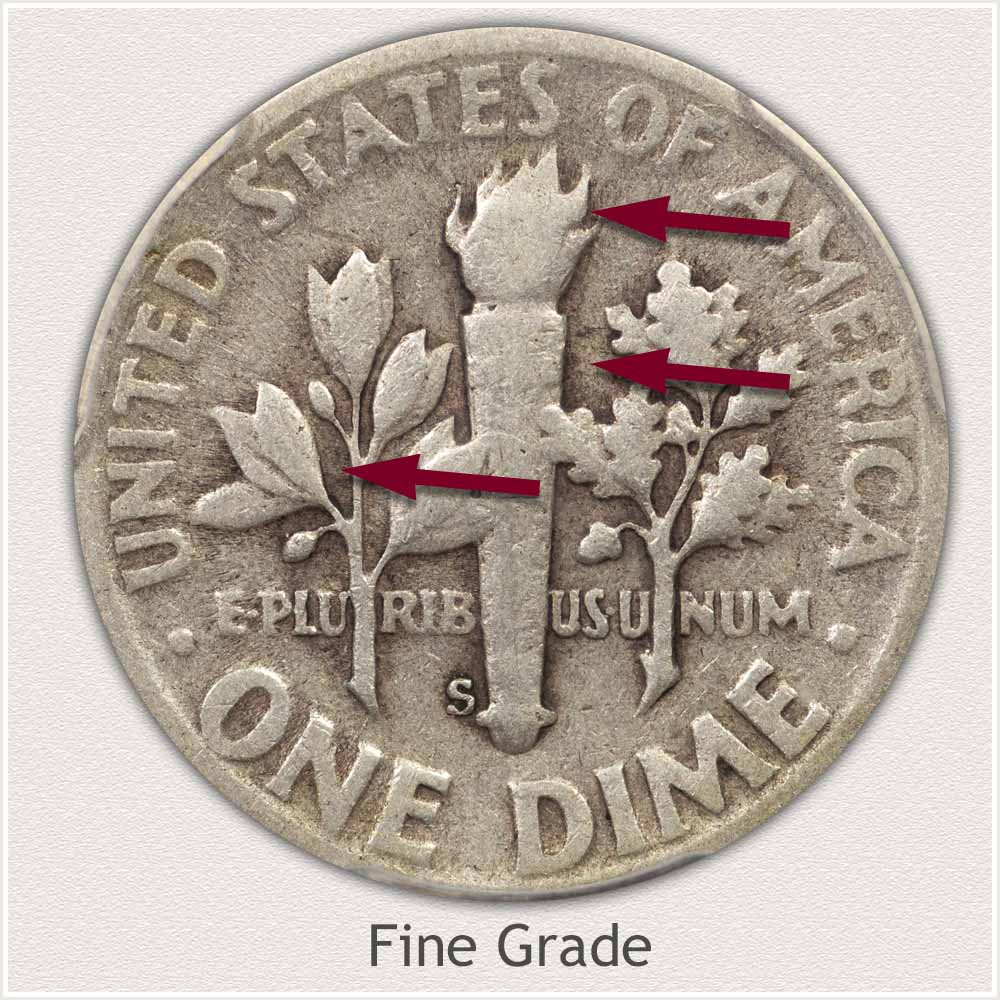
Reverse: Features Identifying the Fine Grade: Most of the fine inner lines to the torch, flame, and leaves are missing.
Once with inner detail, the torch flame is now flat.
Horizontal bands at the top and bottom of the torch handle are worn smooth.
Vertical lines of the torch are mostly merged; a few details show towards edges.
Leaves are flat, no central detail. Each leaf is defined from the next.
Good Grade: Roosevelt Dime
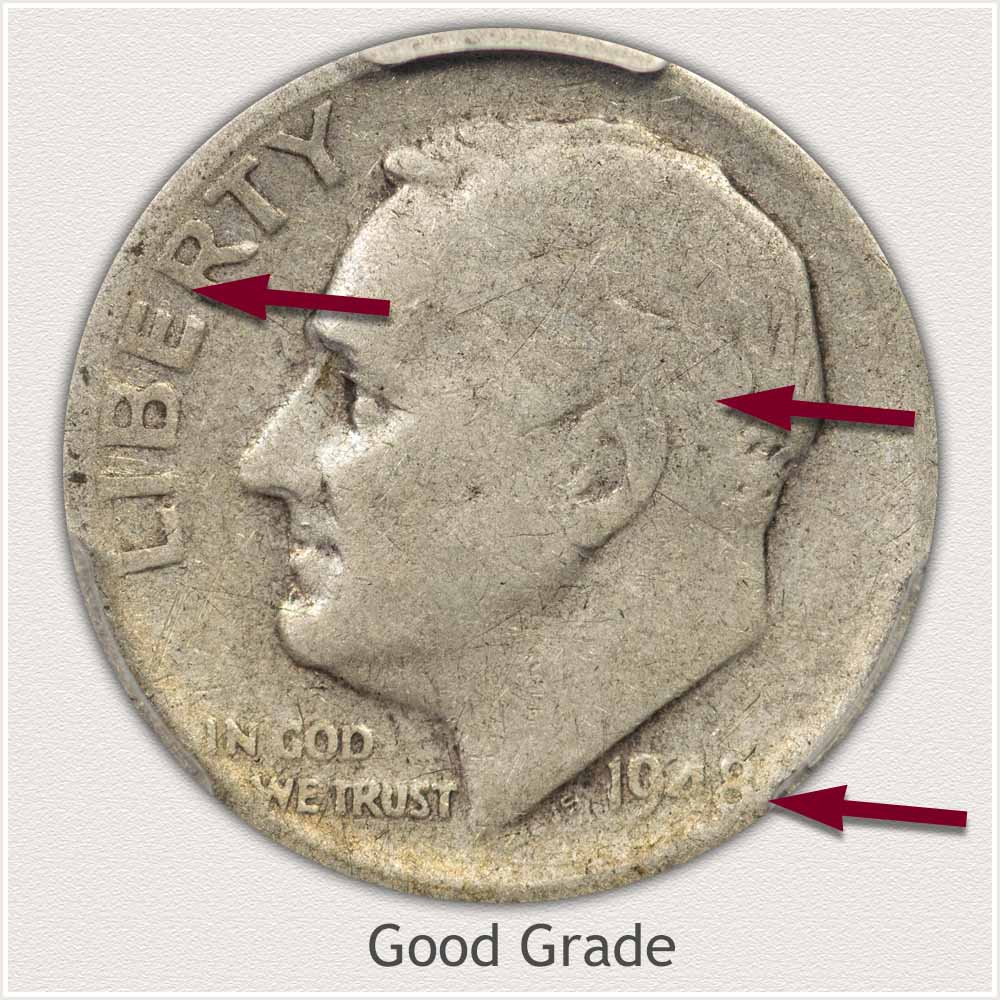
Obverse: Features Identifying the Good Grade: An outline of Roosevelt remains. Wear has removed most detail to his portrait.
Hair is worn smooth leaving just an outline to the ear.
Letters of "Liberty" are faint towards the top. Some of the letters are beginning to connect to the rim.
Date is readable. Often the last digit is weak but readable.
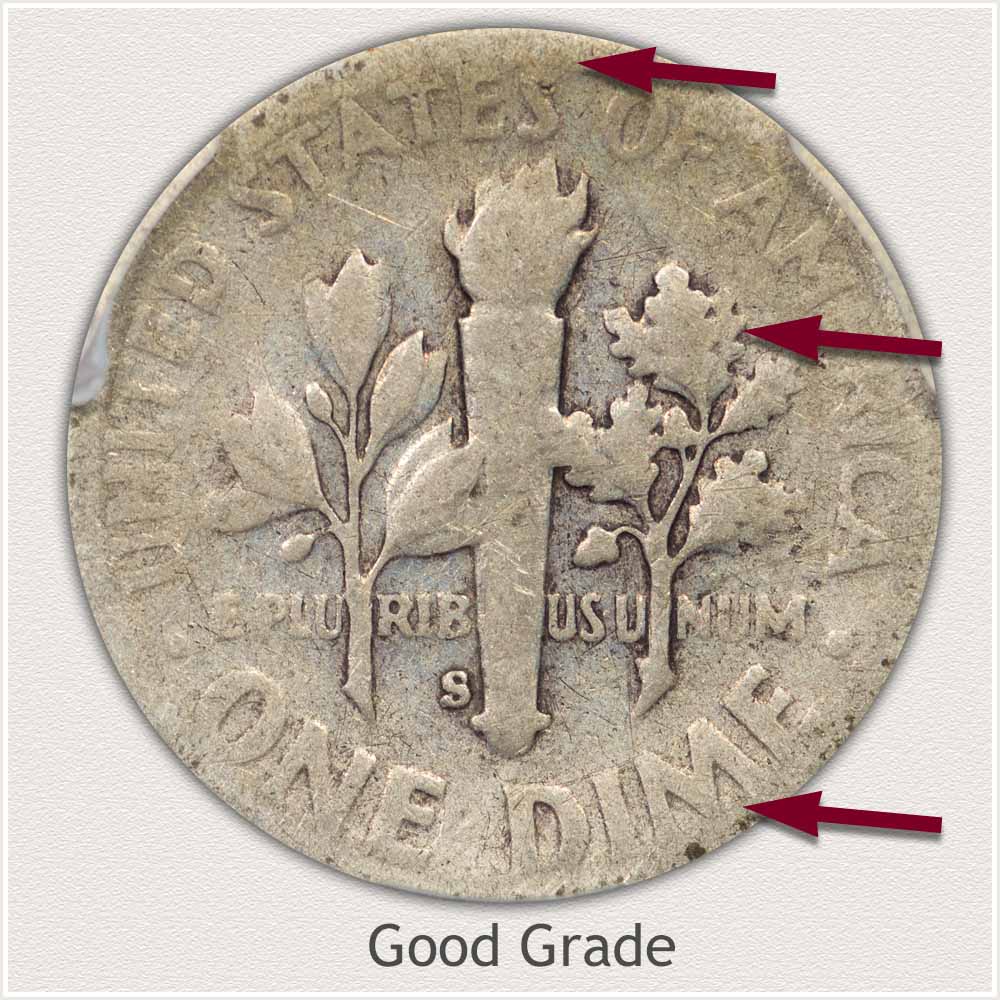
Reverse: Features Identifying the Good Grade: Outlines remain of the torch, leaves of the two branches and flame of torch.
The rim is weak in areas but mostly complete.
Tops of lettering is worn to becoming faint in places.
Edges of leaves are worn and merged forming flat clusters.
Video: Grading Roosevelt Dimes
Grading condition is an important part of determining the difference between the collector quality and bullion quality silver dime. Using a single light source and a magnifying glass are two helpful tools.
How to Video | Grading Roosevelt Dimes
Your primary consideration in grading Roosevelt dimes is the confidence of separating the bullion silver dime pieces from the higher value collectable ones.
Video proceeds through the grading process. Identify the higher mints state grades and better-quality circulated Roosevelt dimes. Close-up images with added descriptions help in judging condition.
Step 3: | Special Qualities of the Silver Roosevelt Dime Variety
Values of silver Roosevelt dimes are influenced and supported by both collectors and the silver bullion market.
Collectors and Their Preferences
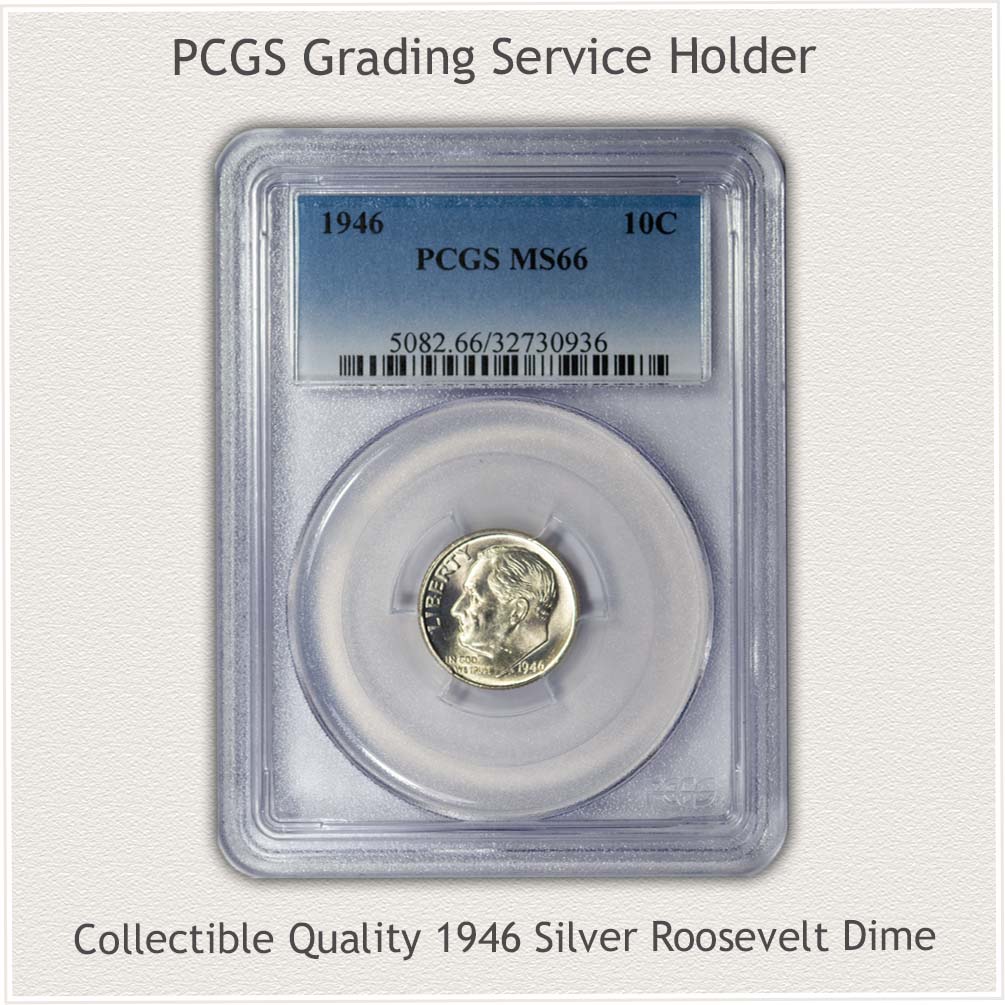
Most collections of the silver era Roosevelt dime are focused on mint state examples. Coins with no wear to the surface, boldly struck, and few marks. Realize within the mint state grade there are levels of preservation. Brighter luster, fewest marks, and overall eye appeal are considered.
Gem quality mint state dimes are highest in demand. These high-end coins are sent to grading services to encapsulate and grade. Once an impartial judgement of grade is made and the coin in in the holder of the service, acceptance of grade in the market improves. A wide value range becomes narrow. Coins outside a grading service holder are also traded in the market, generally a slightly less quality mint state dime.
Silver and Roosevelt Dimes
First era Roosevelt dimes (1946 to 1964) are the silver alloy variety. The majority are valued based on silver content. A movement in the price of silver - up or down - and a bullion quality dime follows. In the market these coins are typically traded in quantities of 50 coins (representing a standard "roll") or more.
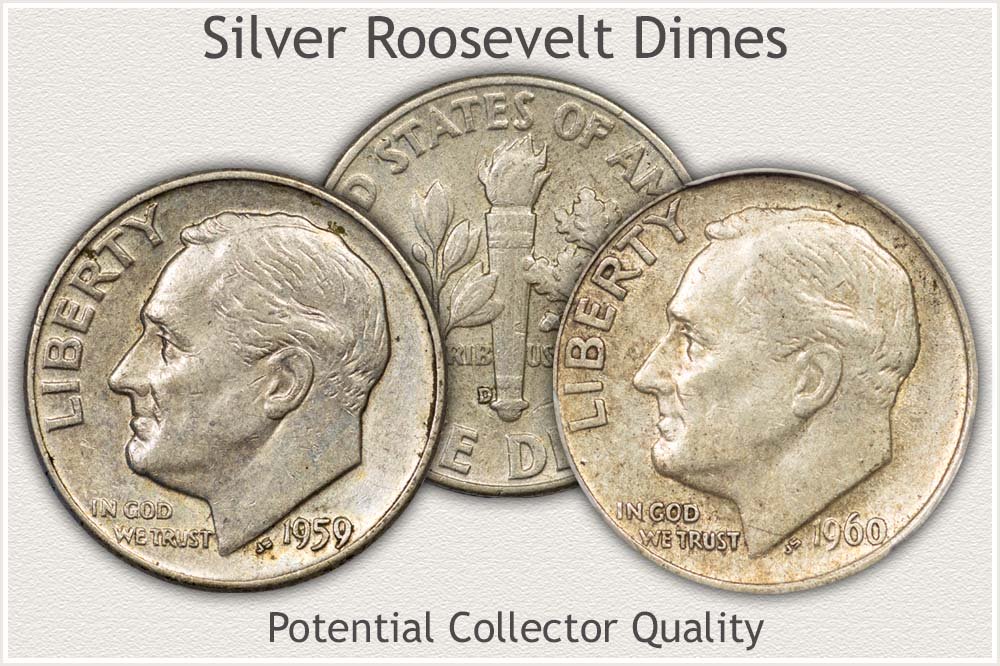
Condition is the key factor identifying a bullion dime. Circulation wear on most dates and mints lowers the coin below collector grade. Highlighted on the value chart a few in Extremely Fine grade are showing a slight premium. When located, these higher quality coins are nice additions to a beginning or your collectors set. Low initial cost and 90% silver combined in an old coin.
Pictured are coins very close, but just missing the mint state grade. Despite the minor circulation wear these have a potential as time passes. By tilting a coin at a sharp angle to a single light; surface wear and the slight smoothing and color change of metal is evident.
References
US Mint. Symbols on Our Coins.
https://www.usmint.gov/learn/history/us-circulating-coins
US Mint. 1946 US Mint Annual Report.
https://nnp.wustl.edu/library/book/514144
Coin Values | CoinStudy Articles
Date by Date
In Depth Roosevelt Dime Values
1946 to 1964
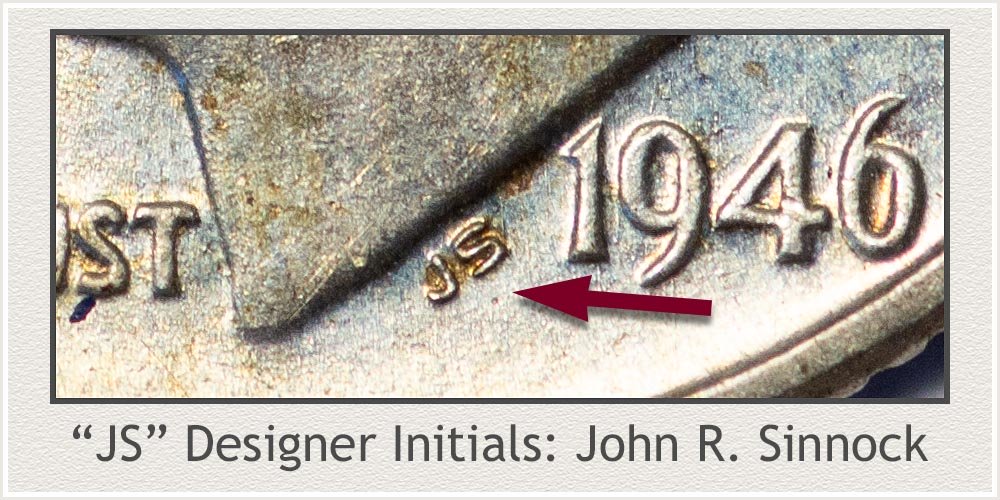
The small letters "JS" at the base of Roosevelt's portrait, next to the date, are the designer's initials. John R. Sinnock was supervisor of all die work at the Philadelphia mint at the time. He personally designed the obverse and reverse, sculpted the model, and engraved the dies for the Roosevelt dime. A long-time designer and engraver at the mint, Mr. Sinnock also designed the Franklin Half dollar of 1948 and commemorative coins dating back to 1925.
Dime Values listed for Bust, Liberty Seated, Barber and Mercury Dimes. Match your coins to the Variety images, date and mintmark, and grading images. Determine a narrow range from the value charts.
Grading Old Dimes || Video Index
Dime series are graded using video, close-up images and descriptions. Barber dimes and Mercury dimes are studied to judge condition.
Grading Old Coins || Video Index
Video index of how to grade coins, videos, close-up images and descriptions of other coin series are found here.
Today's Minimum Silver Coin Values
Many of your old US silver coin values are tied closely to the price of silver. Silver dimes, quarters, half dollars, and silver dollars are all heavy with 90% silver and worth many times their face value. With today's high price of silver your old coins are becoming surprisingly valuable.
Follow the steps to sell silver coins. Determine value first before finding a dealer.
Coin Value Guide | How to Value a Coin Collection
A step by step method combined with the coin value online guide identifies how to value a coin collection. Discover how much your box of old coins is worth.
★ Coin Values Discovery finds Roosevelt Dime Values and...
All old US coin values. It is an excellent index with images and text links to all coin series, from Cents to Gold. Value charts, grading images and a step by step procedure uncovers how much your box of old coins is worth.
Print the Coin Values Worksheet to list Roosevelt dime values. Should you decide to sell... use the worksheet as an invoice and packing slip when sending coins through the mail to dealers. It indicates you have done your coin values homework.
